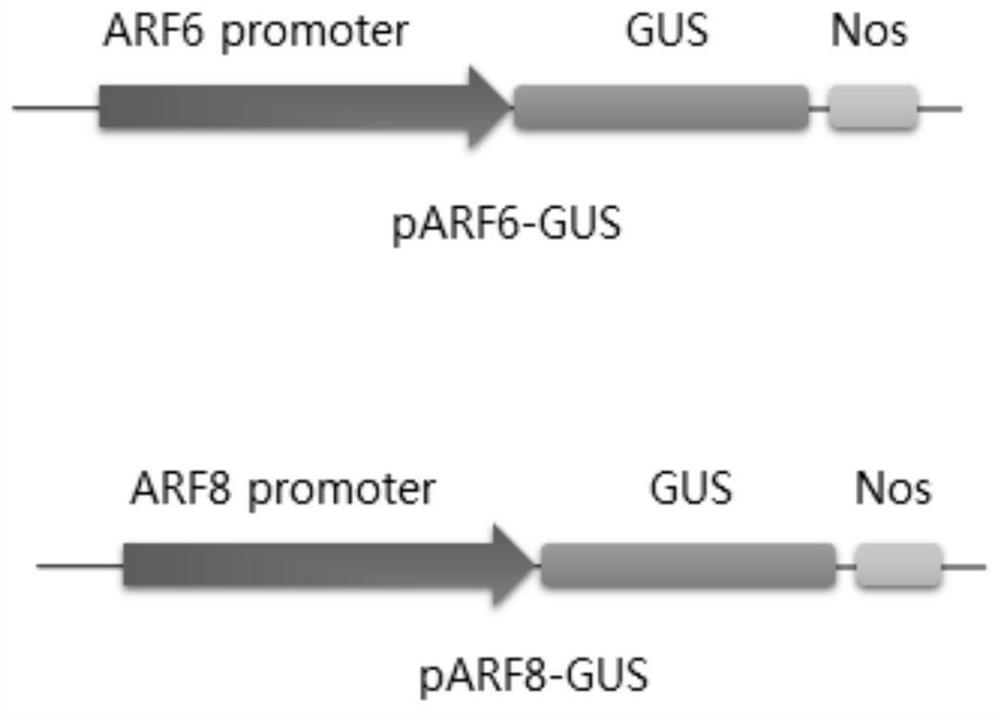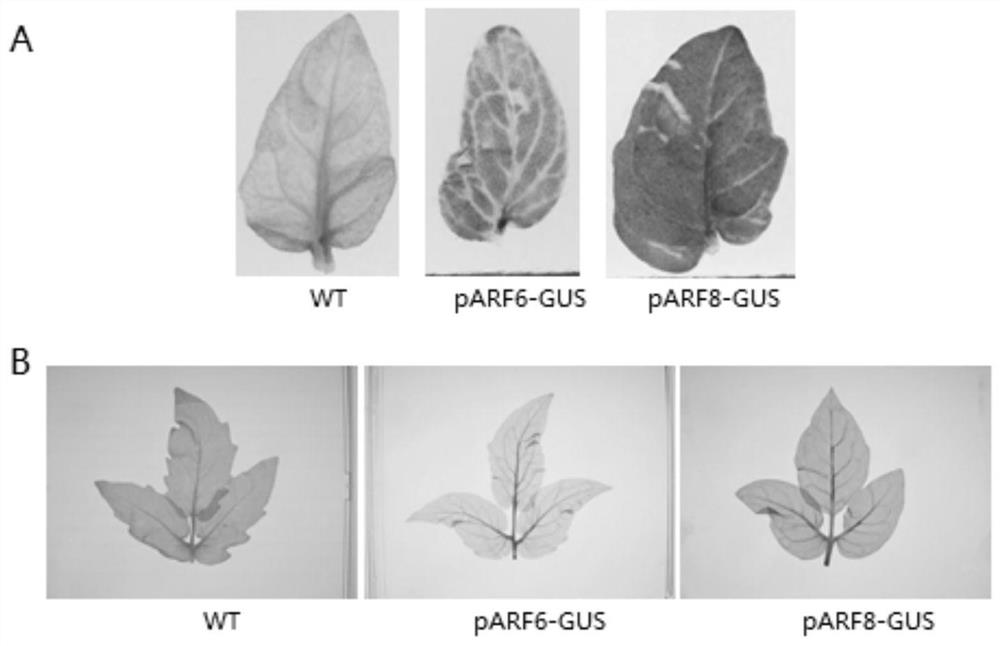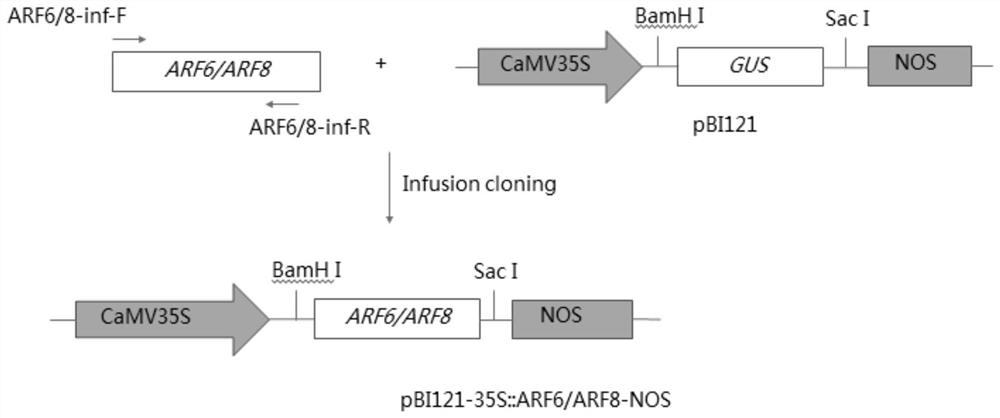Genes related to tomato leaf senescence and their application
A gene and aging technology, which is applied to genes related to tomato leaf aging and its application fields, to achieve obvious effects, increase chlorophyll content, and prolong the viewing period
- Summary
- Abstract
- Description
- Claims
- Application Information
AI Technical Summary
Problems solved by technology
Method used
Image
Examples
Embodiment 1
[0030] tomato gene ARF 6 and ARF Cloning of the promoter of 8 and analysis of GUS histochemical staining
[0031] (1) ARF 6 and ARF Cloning of 8 gene promoters
[0032] Using the CTAB method (RTG2405-01, Zhongke Tairui) to extract tomato genomic DNA, according to the sequence shown in SEQ ID NO.5 and SEQ ID NO.6 pARF 8 and pARF 6 Nucleotide sequence of the promoter, design of primers pARF 8-F, pARF 8-R, pARF 6-F and pARF 6-R, with the extracted genomic DNA as a template, with pARF 8-F (forward primer) and pARF 8-R (reverse primer) as primer for pARF Amplification of 8 promoters to pARF 6-F (forward primer) and pARF 6-R (reverse primer) as primer for pARF 6 Amplification of the promoter.
[0033] The primer sequences are as follows:
[0034] pARF8 -F:5'-TTTACCATGTCCCTACCCTCT-3'
[0035] pARF8 -R:5'-CTTTCTCCAAGACCTCCATT-3'
[0036] pARF6 -F:5'-CGAGATCATTAAGATGTATTTTTGTG-3'
[0037] pARF6 -R:5'-TCCCTCAAATCAACAAACTC-3'
[0038] P CR amplifi...
Embodiment 2
[0060] Example 2 Tomato Gene ARF 6 and ARF Cloning of 8 and construction of expression vector
[0061] (1) ARF 8 and ARF Cloning of 6 genes
[0062] Using Micro Tom tomato leaf tissue as material, RNAiso P lus (9108, Takara) kit and Recombinant DNase I (RNase-free) kit (2270A, Takara), total RNA was extracted according to the instructions, and the concentration of RNA was measured with a micro-spectrophotometer for later use.
[0063] Take about 2.0 μg tomato total RNA, using P crimeScri p t II first-strand cDNA synthesis kit (6210A, Takara), and synthesize the first strand of cDNA according to the instructions.
[0064] according to tomato ARF8 and ARF 6 gene sequences, design specific primers ARF 8-F, ARF 8-R, ARF 6-F and ARF 6-R, In-fusion cloning vector linker sequence and restriction site sequence are introduced into the primer. Using the synthesized cDNA as a template, the ARF 8-F (forward primer) and ARF 8-R (reverse primer) as primer for gene ARF Ampl...
Embodiment 3
[0078] Example 3 Agrobacterium-mediated ARF 8 and ARF 6 Gene transformation and screening of transgenic positive lines
[0079] The recombinant expression vector constructed in Example 2 was made by conventional freeze-thaw method p BI121- 35S : ARF 8-NOS and p BI121- 35S : ARF 6-NOS was transformed into Agrobacterium EHA105 respectively, and then transformed into wild-type tomato (Micro Tom) through the Agrobacterium-mediated method. The specific steps are as follows:
[0080] 1) Cultivation of transformed materials
[0081] After the tomato tissue cultured seedlings were cultivated for 30-40 days under the condition that the culture temperature was 23-25°C, the light was 16 / 8h (day / night), and the light intensity was 10000-12000lux, the leaves of the tissue cultured seedlings with good growth were selected for use. in genetic transformation.
[0082] 2) Conversion
[0083] will contain the recombinant expression vector p BI121- 35S : ARF 8-NOS and p BI121- 35S...
PUM
 Login to View More
Login to View More Abstract
Description
Claims
Application Information
 Login to View More
Login to View More - R&D
- Intellectual Property
- Life Sciences
- Materials
- Tech Scout
- Unparalleled Data Quality
- Higher Quality Content
- 60% Fewer Hallucinations
Browse by: Latest US Patents, China's latest patents, Technical Efficacy Thesaurus, Application Domain, Technology Topic, Popular Technical Reports.
© 2025 PatSnap. All rights reserved.Legal|Privacy policy|Modern Slavery Act Transparency Statement|Sitemap|About US| Contact US: help@patsnap.com



